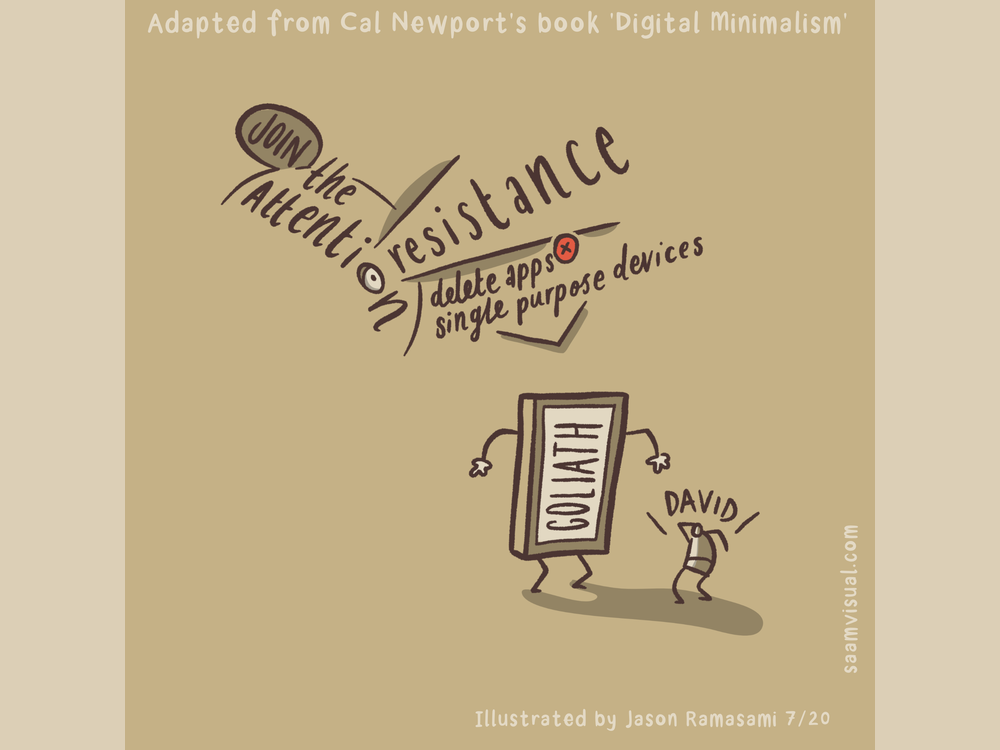Join the Attention Resistance
I was away for work this week, and it was made abundantly clear – almost constantly – how convenient our digital devices make life, whether we’re trying to find an office building, schedule a dinner with friends, or get a ride home. I very notably had to bend my Lenten rules a few times, but specifically for the purpose of notifying others of my ETA when I couldn’t call. As important as this digital detox is to me, my biggest obstacle remains the fact that I hate inconveniencing others with my restrictions on text-based communications.

Image credit: [1]
Aptly, this week’s dive into Cal Newport’s Digital Minimalism, [2] really stressed the concept that these devices are tools to be used to support the things we value – we’re supposed to be using them, not the other way around. He even closed with the reminder that the concept of a digital declutter isn’t supposed to be about adhering to strict rules, but rather about promoting quality of life. To that end, I was a little more flexible when I had to be this week, but I also did some things I don’t normally do – in the spirit of my digital detox – and I loved them.
Vive la Résistance
Newport reminds us in this last of four steps, “join the attention resistance,” that we are in a constant battle for our time and attention, both finite resources. Unfortunately, few of us actually use our tech tools as tools – most of us open them reflexively, without a specific intention, and get sucked in so completely that minutes (and sometimes hours) go by without us noticing. When it comes to the question of whether social media is bad for you, worst-case research says yes, and best-case research says that it depends on how you use the technology – and most of us don’t use it in a healthy way.
We’ve all heard the saying “if a service is free, you’re the product,” and that’s exactly what we are when Facebook sells our attention to advertisers. In 2017, 88% of Facebook’s ad revenue was from mobile, not laptop, interfaces, and that number was still rising. Before the advent of smartphones, advertisers could only grab your attention while you were sitting at your computer, actively browsing websites. But now that we reach for our phones out of habit at the first hint of boredom, we make ourselves a ready and willing audience almost constantly.
As of the writing of this post, Facebook’s parent company Meta has a market cap of $534 Billion, higher than that of Exxon Mobil, which is currently sitting at $421B. Put another way, Meta creates more value for its shareholders by extracting attention from users than Exxon does by extracting oil from the ground. A fun trick mentioned at this point in the book played into the concept of valuing your time as a product that social media companies want. Specifically, start by listing the most important thing(s) that Facebook (or your channel of choice) provides to you, then imagine that they start charging you for the time you’re on their platform. How much would you pay for the time you use it? How much time would you spend there?
Viewing your time and attention as the most precious non-renewable resources you have can be a very effective way to shift your perspective about who or what gets them. And given the power that these social media companies have over us, hacking our brain chemistry to keep us addicted to their products, it makes sense when Newport describes the situation as a David-and-Goliath fight. To that end, this chapter consisted mostly of suggested practices for fighting back.

Suggested Practices
1. Delete social media from your phone
The idea behind deleting social media apps from your phone is that you don’t have to quit these services, but just that you won’t have easy access to them when you’re on the go. I took Facebook off my phone years ago, but I’ve now accessed it through my phone’s internet browser so much that the Chrome icon might as well be the Facebook icon. That was a strong habit I’ve been working to break over the last few weeks, and deleting other apps, such as Messenger, my news outlets, and anything else that pings me with notifications, has provided me with what feels like some breathing space. I’ve also noticed less of a desire to pull out my phone because it doesn’t send reward signals to my brain the way it used to.
2. Turn your devices into single-use computers
One of the biggest benefits of our advanced tools is that single devices can perform many different types of tasks. One of the biggest drawbacks is that we try to do all of those tasks at once and wind up getting pulled in too many directions to be productive. The idea behind this practice is to block your access to social media apps or websites during specific periods of time so that you can remain focused on what you’re trying to accomplish without the distractions that we’ve come to expect as part of daily life. There is even a service – called “Freedom” – that allows you to turn off access to specific apps, websites, games, or even the whole internet across all your devices for blocks of time. [3]
3. Use social media like a professional
If your job is to run digital communications for a company, you likely use social tools and services very differently in getting your job done than most people who are just logging in to scroll through their feeds. By shifting how we use social media platforms, specifically to use them as tools and extract maximum value from them, we can claw back some of our time and attention. The biggest step is not to view social media as a source of entertainment (I’m looking at you, cat meme groups) or for your news.
The more groups you follow means the more notifications you have to read through every time you log in; the more content there is to follow, the more time you’ll spend browsing. If you’re using Facebook to stay in touch with friends (which was the only reason I eventually gave in and signed up), you should try to keep the number of connections you maintain below 150, which is around the cognitive limit for humans when it comes to maintaining relationships.[4] I don’t accept friend requests from people I don’t know, but I still have over 800 connections on Facebook (a total that is actually on the small side among people I know).
I am not on Twitter or Instagram, so I am less familiar with those interfaces, but Newport mentions tools such as Tweetdeck, a desktop-only Twitter management tool that enables you to filter content to focus on relevant information from verified accounts.[5] Digital Minimalism was published in 2019, before the complications Twitter has seen in more recent years, so I don’t know how effective Tweetdeck still is for the purposes described in the book, but the point remains that whenever we log on to any social media platform, we should have an understanding of why we’re there as well as a plan of how to get in, get what we need, and get back out.

Image credit: [6]
4. Embrace slow media
In our world of constant connectivity, it is extremely tempting to check in on news updates all the time. My BBC News app would regularly alert me to “breaking news” that wasn’t particularly urgent or interesting, which made me wonder how it got that label in the first place. I also know from watching enough breaking news on TV over the years that it often isn’t particularly informative – small bits of the story that are available in the early stages of development often just get repeated and reacted to until more facts come to light. The “slow media” movement stresses periodic (e.g. once-daily) consumption of high-quality content, rather than ritualistic checking of multiple news outlets multiple times per day.[7] Ultimately, decide how and when you will consume your news, make sure you’ve got a trustworthy source, and ideally seek out trustworthy arguments that are counter to your own viewpoint in order to help break down the media echo chambers where we often find ourselves.[8]
5. Dumb down your smartphone
The last recommendation is to consider ditching your smartphone altogether. Some executives have made the switch to an old-school flip phone or a “light phone” [9] and noted increased productivity at work and more focused attention on their families at home. The idea is that a phone can be used for calls and messages, while laptops can be used for everything else… though I would argue that my phone came in quite handy for taking pictures, looking at directions, and getting rides while I was out and about in DC this week. Newport mentions that if you feel like you have a good relationship with your phone, it might not be worth switching it out – smartphones are not forbidden in the world of digital minimalism if, once again, you can effectively use yours as a tool and not let it use you instead.
~
I have now hit the 30-day mark of this digital detox, and I know I am slipping in my resolve in some areas, particularly when it comes to texting. I’ve still got two more weeks of Lent to go, and I will spend them thinking about how to build (and stick to) healthier habits with my phone and with social media, post-Easter.
Thanks for reading!
[1] https://saamvisual.com/process/2020/7/21/calnewport-digitalminimalism
[2] https://www.goodreads.com/book/show/40672036-digital-minimalism
[4] https://en.wikipedia.org/wiki/Dunbar%27s_number
[5] https://www.razorsocial.com/tweetdeck-for-twitter-management/
[6] https://www.healthline.com/health/social-media-addiction
[7] https://slow-media.org/resources
[8] https://radicalmoderate.online/bias-in-the-media/
[9] https://www.thelightphone.com/
0 Comments